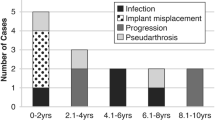Abstract
Study Design
A retrospective, long-term follow-up study.
Objective
We investigated the incidence and risk factors for osteopenia at a minimum of 20 years after spinal instrumented fusion for adolescent idiopathic scoliosis (AIS).
Summary of Background Data
Surgically treated AIS patients may be likely to have osteopenia in adulthood because the association between AIS and osteopenia has been well documented. However, the long-term results of AIS surgery on BMD have not been evaluated.
Methods
Twenty-one (19 women; mean age, 45.3 years) of 45 consecutive patients with AIS who underwent spinal instrumented fusion surgery between 1973 and 1994 consented to inclusion in the current analysis. Based on their T scores for bone mineral density (BMD) of the left hip, participants were divided into an osteopenia/osteoporosis group (group P, T score < −1.0) and a normal group (group N, T score ≤ −1.0). Z scores of the left hip were used for analyses of the association between bone mineral status and individual factors.
Results
Eleven participants (52.4%) were categorized into group P. Mean body weight (kg) at survey (46.6 vs. 56.8) and mean body mass index (BMI) at both surgery (17.2 vs. 19.5) and survey (18.7 vs. 23.2) were significantly lower in group P than in group N (p < .05). Moreover, body weight at survey (Spearman rank correlation coefficient, rS = 0.49), as well as BMI at both surgery (rS = 0.67) and survey irS = 0.61) demonstrated positive correlations with the Z-score (p < .05).
Conclusion
More than half of the participants had osteopenia or osteoporosis, and both preoperative and postoperative low BMI were risk factors for osteopenia in adulthood.
Level of Evidence
Level IV.
Similar content being viewed by others
References
Lonstein JE. Scoliosis: surgical versus nonsurgical treatment. Clin Orthop Relat Res 2006;443:248–59.
Li XF, Li H, Liu ZD, et al. Low bone mineral status in adolescent idiopathic scoliosis. Eur Spine J 2008;17:1431–40.
Hung VW, Qin L, Cheung CS, et al. Osteopenia: a new prognostic factor of curve progression in adolescent idiopathic scoliosis. J Bone Joint Surg Am 2005;87:2709–16.
Akazawa T, Minami S, Kotani T, et al. Health-related quality of life and low back pain of patients surgically treated for scoliosis after 21 years or more of follow-up. Comparison among nonidiopathic scoliosis, idiopathic scoliosis, and healthy subjects. Spine 2012;37:1899–903.
Iida T, Suzuki N, Kono K, et al. Minimum 20 years long-term clinical outcome after spinal fusion and instrumentation for scoliosis: comparison of the SRS-22 Patient Questionnaire with that in nonscoliosis group. Spine 2015;40:E922–8.
Simony A, Hansen EJ, Carreon LY, et al. Health-related quality-of-life in adolescent idiopathic scoliosis patients 25 years after treatment. Scoliosis 2015;10:22.
Lenke LG, Betz RR, Harms J, et al. Adolescent idiopathic scoliosis: a new classification to determine extent of spinal arthrodesis. J Bone Joint Surg Am 2001;83:1169–81.
Ylikoski M. Height of girls with adolescent idiopathic scoliosis. Eur Spine J 2003;12:288–91.
Japanese Ministry of Health, Labour and Welfare. National Health and Nutrition Survey, http://www.mhlw.go.jp/. Accessed September 11, 2016.
Fukuhara S, Bito S, Green J, et al. Translation, adaptation, and validation of the SF-36 Health Survey for use in Japan. J Clin Epidemiol 1998;51:1037–44.
Hashimoto H, Sase T, Arai Y, et al. Validation of a Japanese version of the Scoliosis Research Society-22 Patient Questionnaire among idiopathic scoliosis patients in Japan. Spine 2007;32:E141–6.
Yoshimura N, Muraki S, Oka H, et al. Prevalence of knee osteoarthritis, lumbar spondylosis, and osteoporosis in Japanese men and women: the research on osteoarthritis/osteoporosis against disability study. J Bone Miner Metab 2009;27:620–8.
Iki M, Kagamimori S, Kagawa Y, et al. Bone mineral density of the spine, hip and distal forearm in representative samples of the Japanese female population: Japanese Population-Based Osteoporosis (JPOS) Study. Osteoporos Int 2001;12:529–37.
Cosman F, de Beur SJ, LeBoff MS, et al. Clinician’s guide to prevention and treatment of osteoporosis. Osteoporos Int 2014;25:2359–81.
Weaver CM, Gordon CM, Janz KF, et al. The National Osteoporosis Foundation’s position statement on peak bone mass development and lifestyle factors: a systematic review and implementation recommendations. Osteoporos Int 2016;27:1281–386.
Wu SF, Du XJ. Body mass index may positively correlate with bone mineral density of lumbar vertebra and femoral neck in postmenopausal females. Med Sci Monit 2016;22:145–51.
Miyabara Y, Onoe Y, Harada A, et al. Effect of physical activity and nutrition on bone mineral density in young Japanese women. J Bone Miner Metab 2007;25:414–8.
Kuroda T, Onoe Y, Miyabara Y, et al. Influence of maternal genetic and lifestyle factors on bone mineral density in adolescent daughters: a cohort study in 387 Japanese daughter-mother pairs. J Bone Miner Metab 2009;27:379–85.
Dobashi K. Evaluation of obesity in school-age children. J Atheroscler Thromb 2016;23:32–8.
Orito S, Kuroda T, Onoe Y, et al. Age-related distribution of bone and skeletal parameters in 1,322 Japanese young women. J Bone Miner Metab 2009;27:698–704.
Ogden CL, Yanovski SZ, Carroll MD, et al. The epidemiology of obesity. Gastroenterology 2007;132:2087–102.
Tanaka S, Kuroda T, Saito M, et al. Overweight/obesity and underweight are both risk factors for osteoporotic fractures at different sites in Japanese postmenopausal women. Osteoporos Int 2013;24:69–76.
Centers for Disease Control and Prevention. Overweight & obesity, https://www.cdc.gov/obesity/childhood/index.html. Accessed July 5, 2016.
World Health Organization. Obesity and overweight, http://www.who.int/mediacentre/factsheets/fs311/en/. Accessed July 5, 2016.
Author information
Authors and Affiliations
Corresponding author
Additional information
MO (none); TH (none); KW (none); KK (none); HS (none); TM (none); NE (none).
Rights and permissions
About this article
Cite this article
Ohashi, M., Hirano, T., Watanabe, K. et al. Bone Mineral Density After Spinal Fusion Surgery for Adolescent Idiopathic Scoliosis at a Minimum 20-Year Follow-up. Spine Deform 6, 170–176 (2018). https://doi.org/10.1016/j.jspd.2017.09.002
Received:
Accepted:
Published:
Issue Date:
DOI: https://doi.org/10.1016/j.jspd.2017.09.002




